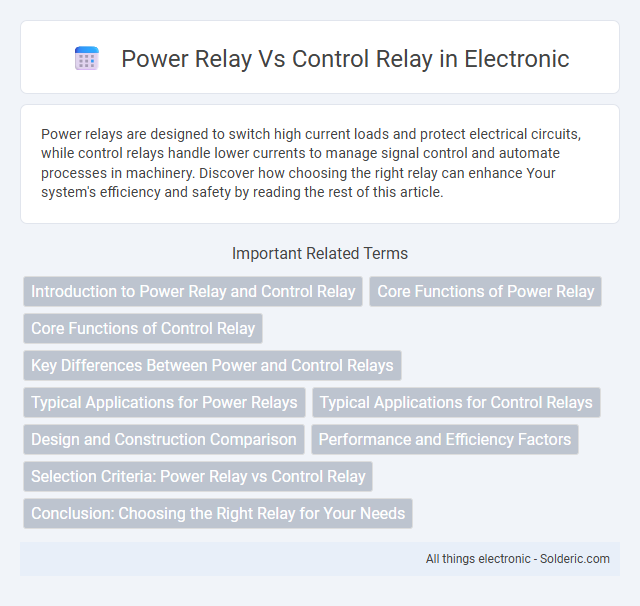Power relays are designed to switch high current loads and protect electrical circuits, while control relays handle lower currents to manage signal control and automate processes in machinery. Discover how choosing the right relay can enhance Your system's efficiency and safety by reading the rest of this article.
Comparison Table
| Feature | Power Relay | Control Relay |
|---|---|---|
| Primary Function | Switching high power electrical circuits | Controlling low power control circuits |
| Current Handling | High current (typically above 10A) | Low current (usually below 10A) |
| Contact Rating | High voltage and current rating | Low voltage and current rating |
| Size | Larger in size due to heavy-duty contacts | Smaller and compact design |
| Typical Application | Motor starters, power switching | Logic control circuits, automation |
| Coil Voltage | Usually 24V, 48V, or higher | Typically 12V, 24V, or control voltages |
| Response Time | Slower due to large contact movement | Faster switching for control signals |
| Durability | Designed for heavy-load operations | Designed for frequent switching cycles |
Introduction to Power Relay and Control Relay
Power relays are designed to switch high current loads and are commonly used in industrial equipment to control large electrical devices. Control relays handle lower current signals and are typically employed in automation and control systems to manage electrical circuits. Understanding the differences between power relay and control relay helps you choose the right component for efficient electrical system management.
Core Functions of Power Relay
Power relays are designed to switch high current loads, typically handling voltages ranging from 24V to several hundred volts and currents up to hundreds of amps. Their core function involves controlling heavy electrical equipment such as motors, heaters, and transformers by isolating control circuits from high-power circuits for safe operation. Your choice of a power relay ensures reliable handling of large electrical loads with enhanced durability and protection against overloads and voltage spikes.
Core Functions of Control Relay
Control relays primarily manage low-power circuits by opening or closing contacts to control electrical devices, enabling precise automation and signal switching. They serve as intermediaries in control systems, ensuring your machinery operates safely and efficiently by responding to specific inputs or conditions. Unlike power relays that handle high current loads, control relays focus on accurate control functions essential for complex industrial processes.
Key Differences Between Power and Control Relays
Power relays handle high current loads typically above 10 amps and are used to switch heavy electrical equipment like motors and heaters. Control relays manage low current circuits, designed for signaling and control functions within automation systems, often operating below 10 amps. Your choice depends on the load requirements and switching capabilities needed for your application.
Typical Applications for Power Relays
Power relays are commonly used in high-current applications such as motor control, lighting systems, heating elements, and industrial machinery where they handle heavy electrical loads. They are essential in circuits requiring switching of large voltages or currents, such as HVAC systems, automotive circuits, and power distribution units. These relays support reliable operation in environments with frequent switching and high inrush currents.
Typical Applications for Control Relays
Control relays are commonly used in automation systems, motor starters, and lighting control circuits to manage low-power signals and execute switching functions safely. They play a critical role in industrial machinery by enabling the control of high-voltage power devices indirectly through low-voltage control signals. Typical applications include sequential control of machines, interlocking systems, and safety shutdown mechanisms where precision and rapid switching are essential.
Design and Construction Comparison
Power relays are designed with robust contacts and thicker, high-current coils to handle heavy electrical loads, often found in industrial and automotive applications. Control relays feature lighter construction with smaller coils and contacts optimized for signal switching and low-current circuits, enabling precise control in automation systems. Your choice depends on the required current capacity and application demands, balancing durability and control precision.
Performance and Efficiency Factors
Power relays offer higher current and voltage handling capabilities, making them suitable for heavy-duty applications with significant electrical loads. Control relays emphasize precision and faster switching times, enhancing operational accuracy and reducing response latency in control circuits. Efficiency in power relays is measured by their ability to manage thermal dissipation and minimize contact wear, while control relays optimize coil power consumption and signal integrity for improved system performance.
Selection Criteria: Power Relay vs Control Relay
Power relay selection criteria emphasize current rating, voltage capacity, and contact configuration to handle high power loads efficiently, while control relays prioritize coil voltage, switching speed, and isolation for signal control in low power circuits. Power relays are chosen based on their ability to manage heavy electrical loads and withstand mechanical stress, whereas control relays are selected for electrical isolation, precise control, and integration with automation systems. Environmental factors, load type, and application frequency also influence the decision between power relays and control relays.
Conclusion: Choosing the Right Relay for Your Needs
Power relays are designed for switching high voltage or high current loads, providing robust performance in industrial applications, while control relays handle lower voltage signals to manage circuit control and automation tasks. Selecting the appropriate relay depends on load requirements, voltage rating, and control complexity to ensure optimal system reliability and efficiency. Understanding the specific operational demands helps in choosing between power relays for heavy-duty switching and control relays for precise control functions.
Power Relay vs Control Relay Infographic

 solderic.com
solderic.com